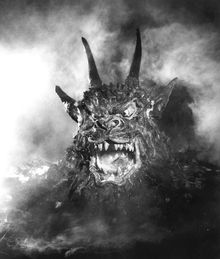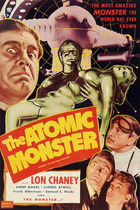Our editor-in-chief Nate Yapp is proud to have contributed to the new book Hidden Horror: A Celebration of 101 Underrated and Overlooked Fright Flicks, edited by Aaron Christensen. Another contributors include Anthony Timpone, B.J. Colangelo, Dave Alexander, Classic-Horror.com's own Robert C. Ring and John W. Bowen. Pick up a copy today from Amazon.com!
Curse of the Demon (1957)
The black and white Curse of the Demon made its American debut in 1958 as the bottom half of a double bill with the Hammer sequel Revenge of Frankenstein. 96 minutes long in its initial British release the year before, it had been cut by 14 minutes and retitled (it was originally called Night of the Demon). Not an auspicious beginning for a classic. Curse of the Demon deserves the accolades it eventually received; it’s a gem, though not a flawless one.
The hero of Curse of the Demon is Dr. John Holden (Dana Andrews), an American psychologist visiting England. He’s attending a scientific symposium investigating “international reports of paranormal psychology.” More specifically he’s bent on exposing the “fraudulent” satanic cult led by one Julian Karswell, a wealthy local landowner. Shortly before Holden’s arrival his partner in the investigation, Dr. Henry Harrington, is killed, supposedly electrocuted by falling power lines after his car crashes into a pole. This explains his death, but not the horrible mutilation of his body. His pretty niece, schoolteacher Joanna Harrington (Peggy Cummins), thinks it was foul play, and warns Holden that he may be in danger. Karswell echoes Joanna’s warning with a threat – he tells Holden that if he doesn’t halt his investigation, he’ll die in three days. Skeptic Holden dismisses this notion – but begins to experience blurred vision and chills, hear strange sounds, and he feels he’s being followed. He and Joanna discover that Karswell has passed him a slip of paper with runic inscriptions written on it, just as the occultist did to her late uncle. The runes are meant to attract a homicidal monster. As the three days pass, the curse’s symptoms and signs grow more overt and menacing.
Curse of the Demon is based on the short story “Casting The Runes” by British college provost M.R. James (1862-1936). James based Karswell on Aleister Crowley (1875-1947), a well-known occultist notorious for his then shocking hedonism and public blasphemy. James’s Karswell casts his hex when a psychic research association declines to read his paper on alchemy at their forthcoming meeting. As James describes Karswell, “he had invented a new religion for himself…he was very easily offended, and never forgave anybody… whatever influence he did exert was mischievous.” Crowley did invent the religion Thelema, an imaginative eclectic mishmash of the Cabala, I Ching, Freemasonry and other influences. Though not a Satanist, he scandalized England by calling himself “The Beast,” as if he were the Antichrist. Though he was serious about his ideas, many of his more lurid shenanigans were calculated to attract public attention. James’s Karswell shows magic lantern slides at a party for the village children intended to frighten them, depicting a boy followed by “a horrible hopping creature in white dodging about among the trees.”
The movie’s Karswell is actually quite likable, which makes him a disarming and unique villain. Holden and Joanna find Karswell entertaining delighted children at Halloween in clown makeup and a top hat, from which he pulls puppies. This Karswell wants to be left alone; when Prof. Harrington offers him a newspaper retraction, he refuses, wanting only privacy for himself and his followers. He’s witty and charming, well versed in his “field,” more than a match verbally for the endlessly earnest scientists who seem slow compared to him. As Karswell, the short, balding Niall MacGinnis easily steals almost every scene he’s in.
We also like Karswell’s batty but kind spiritualist mother (Athene Selyler), who stages a séance to try to dissuade Holden from his investigation. The séance starts off amusingly, with medium Mr. Meek (Reginald Beckwith) speaking in the voices of his various “spirit guides,” including a garrulous Scotsman named MacGregor and a whiny little girl with a doll named Federica. The ceremony becomes scary when Meek speaks in the voice of Joanna’s late uncle, blurting out, “It’s in the trees – it’s coming!” Joanna trusts Mrs. Karswell and believes it really is her uncle’s voice. But Holden is openly rude to the séance participants and storms out before it’s over, breaking the circle.
The Holden character is entirely an invention of the film – he doesn’t appear in James’s story. He replaces James’s Edward Dunning, who rejects Karswell’s manuscript in the story. Holden is not a very likeable innovation. He is not only skeptical but smug; he flirts persistently with Joanna while she is clearly trying desperately to save his life. At one point he tells her, “I have an imagination like anyone else,” but he keeps blaming his less and less explainable traumas on theatrical trickery. He angrily tells Joanna about how he deliberately walked under ladders as a kid “to prove I’m not a superstitious sucker like 90% of humanity.” Of all the symposium scientists, he alone completely dismisses the possibility of the supernatural. If Andrews were less handsome and Holden were not in such palpable danger, our sympathies might not lie with him at all. In the story, Karswell’s brother, not his niece, comes to Dunning’s rescue; Joanna is also a cinematic invention, inserted for the sake of the required love interest. All the faults that lessen our ability to identify with Holden exist only to stimulate fireworks between them. Their relationship can develop slowly, building another tension, because they quarrel frequently.
Another area where the film and story differ concerns Karswell’s wealth. James presents Karswell’s income as a mystery to his neighbors (Crowley came from an affluent family but ultimately squandered his resources). In the film, Karswell says his wealth comes from his followers – and he has a huge, opulent mansion surrounded by extensive grounds. When the usually unimpressed Holden first visits the house he exclaims that he’d like to know what Karswell’s “racket” is. However, Karswell’s handful of followers are depicted as dirt poor farmers. It would take thousands of them to support him in such grand style, making him a satanic Pat Robertson. This is amplified in the original Night of the Demon. The only substantial scene missing from Curse is Holden’s visit to the weed-overgrown Hobart family farm. Hobart (Brian Wilde) is a Karswell follower, now catatonic, who Holden interrogates under hypnosis at the symposium. Beforehand Holden goes to the farm to obtain permission from Hobart’s family -- a spooky bunch. The scene is unnerving, but it makes Karswell’s riches implausible. I can see the wisdom of cutting it.
One final difference between the film and story deserves mention. A minor character invented for the film who works perfectly is Professor Kumar (Peter Elliott). a Hindu psychologist at the symposium who only appears briefly a couple of times. His sole purpose seems to be to say clever things about the devil – such as “he is at his most dangerous when he’s being pleasant” – smiling brightly all the while. His presence adds a great deal of atmosphere. He remains in both versions of the film.
 It's in the trees! It's coming! A publicity still from Jacques Tourneur's Curse of the Demon (1957). Image from wrongsideoftheart.com.
It's in the trees! It's coming! A publicity still from Jacques Tourneur's Curse of the Demon (1957). Image from wrongsideoftheart.com.A major conflict between director Jacques Tourneur and producer Hal E. Chester marks Curse of the Demon. Chester wanted to show the demon clearly and more often; Tourneur, veteran director of such subtle horror classics as Cat People and I Walked with a Zombie, and protégé of tasteful producer Val Lewton, wanted it glimpsed for only four frames at the climax. Comparing Tourneur’s and Chester’s visions is similar to comparing the story and the film. We never see the demon at all in James’s story – all the violence happens offstage, related later by characters who didn’t witness it directly. Tourneur stuck to his guns, but later Chester added footage showing the demon. Tourneur said in a 1973 interview that Chester’s changes “cheapened it.” Many fans who found scenes of the demon mesmerizingly eerie would disagree. The demon’s appearances to Holden unfold in a gradual process. It slowly manifests itself a bit more clearly, and comes a bit closer, each time. A billowing cloud which may have flames inside it pursues Holden through Karswell’s woods, changing shape and surging forward until Holden falls and rolls around to face it – and then recedes, since his “time allowed” is not up. Each appearance is accompanied by maddening twittering and rustling sounds, continually getting louder, that seem to come not from the demon but the atmosphere it creates to materialize in. This clearly evokes the sense that this creature is entering our world from another hidden, inner one. There is a significant gaffe in that we first see the demon too early, soon after the opening credits, but overall, the demon sequences hold up well even now, despite their dated use of puppets.
The current DVD contains both versions of the film. Fans will want to watch Night of the Demon first to see what they’ve missed. But Curse is the tighter of the two versions, so it’s likely to be the preferred choice for repeated viewings. The image and sound are crystal clear, which makes up for the lack of extras – all we get are trailers for each version. But who needs extras when the movie alone shines so brightly? The cast is dead-on perfect; director Jacques Tourneur achieves a suspenseful pace; exquisite cinematography by Ted Saife and a compelling symphonic score by Clifton Parker don’t hurt either. Despite some flaws in Charles Bennett’s mostly involving script and some controversial meddling after initial shooting, Curse of the Demon remains one of the eeriest and most haunting films of the fifties – a decade that gave us so many horror classics.









In the movie, the home of
In the movie, the home of Julian was called "Lufford Hall". Was Brockett Hall north of London used for the filming of scenes at Julian's home? Thanks
"It's in the trees! It's
"It's in the trees! It's coming!" was later sampled by British pop weirdo Kate Bush for her classic "Hounds of Love" song from the album..."Hounds of Love."